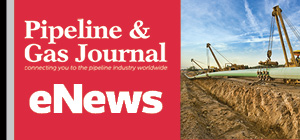February 2025, Vol. 252, No. 2
Editor's Notebook
Editor’s Notebook: Fire Fuels Pipeline Concerns

By Michael Reed, Editor-in-Chief
(P&GJ) — The wildfires on the West Coast not only resulted in untold devastation and the loss of life throughout the region but also served as yet another subtle reminder of the importance of pipelines.
When the CALNEV and Santa Fe Pacific Pipelines (SFPP) West pipelines were shut down due to power outages near the California blazes, concern quickly escalated over the availability of gasoline, diesel and jet fuel in the region, particularly in Los Angeles and the Las Vegas valley.
The bulk of that concern focused on the two pipelines, which fortunately were able to return to service Jan. 10, two days after being taken off line, according to Kinder Morgan.
However, that did not occur before Clark County, Nevada, officials, where Las Vegas is located, felt compelled to ask residents to not “panic buy at the pump.” It seems when it comes to potential not being able to drive, people tend to react quickly.
While the situation was resolved fairly quickly, the incident highlighted the potential vulnerability of the fuel supply chain to natural disasters. Obviously, the fires’ impact extended beyond immediate fuel concerns, affecting broader supply chains, including road transport, port operations and air cargo movement.
The CALNEV pipeline supplies 90% of Clark County’s fuel needs, and the SFPP supplies fuel to areas in California and Arizona. The pipeline is one of two feeding storage tanks in southern Nevada with gasoline and diesel fuel, to be shipped by truck to gas stations.
“In working with California, a solution has been put in place, which will power the Kinder Morgan fuel line into southern Nevada and fuel should start to flow into the valley in the next 12-24 hours,” a county spokesperson told the media at the time. “Clark County Office of Emergency Management remains engaged on this issue with regional and state partners.”
Comprised of two parallel pipelines of 14 and 8 inches, the CALNEV runs about 550 miles (890 km) from Los Angeles refineries and marine terminals to points in Colton and Barstow, California, before arriving at Nellis Air Force Base, south of North Las Vegas, Nevada. It has a capacity of 128,000 bpd.
The other pipeline is part of the SFPP West, which is comprised of several pipes that range in size from 4 to 24 inches. It covers a total of 3,400 miles with key routes ranging in distances from the 13-mile Watson Station to Norwalk Station, in California; to the 864-mile North Line from San Francisco Bay Area to various cities in California and Nevada.
While the five refineries located in the Los Angeles and Long Beach were not under direct threat from the fires, due to California and Nevada’s frequent wildfires, local authorities and utility companies have developed emergency plans to safeguard critical infrastructure and backup supply routes.
These include the use of remote sensors, real-time monitoring of weather and fire risk, generators and backup power, smart grid technologies and collaboration with fire agencies.
Additionally, owner/operators, in some cases, build pipelines with materials able to withstand higher temperatures or bury them at deeper depths in high-risk areas.
Other safety measures include:
- Using aerial patrols and advanced monitoring systems to detect potential threats from wildfires near pipelines.
- Developing comprehensive plans to quickly shut down pipelines in case of a wildfire threat and to manage potential leaks or ruptures.
- Clearing vegetation around pipeline corridors to reduce fuel available for wildfires.
The West Line supplies 60% of Nevada’s refined products and two-thirds of the supply in Arizona.
Welcome to the Energy Pipelines Conference
We at Pipeline & Gas Journal are in the process of putting the final touches on a pipeline conference (similar to the old Pipeline Opportunities Conference) on March 5, at Brown Auditorium in Houston.
We’ll have speakers from INGAA, Williams Henkels & McCoy, Michels, Troy Construction, Rice University’s Baker Institute, Baker Hughes and more, addressing what midstream companies can expect for the coming year and beyond.
The event will be held in conjunction with our Gulf Energy Information’s Underground Infrastructure Conference (UIC), and I’d like to take this opportunity to invite each of you to register and join us.
Agenda: Energy Pipelines: Construction & Corrosion.
Registration: One-Day registration covers all the Energy Pipelines Event





Comments